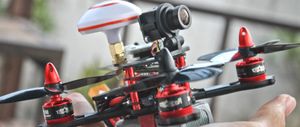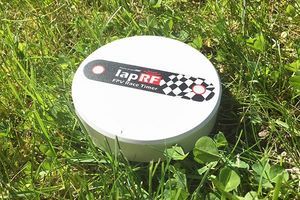Everyone seems to be talking about the new design Pagoda-2 antenna as THE antenna to have for FPV racing and flying – but why? Is it actually better than the antenna that are currently on the market? Let’s have a closer look…

The Specs
- Center frequency: 5.8 GHz
- Bandwidth: 500 MHz (5.55 – 6.05 GHz)
- Matching: S11 < -20 dB, VSWR < 1.22 (at center frequency)
- Axial ratio: < 1.3
- Radiation efficiency: 95%
- Polarisation: RHCP or LHCP
- Weight: 8.9g
- Size: 80mm x 22.5mm
- Connector: SMA or RP-SMA (crimp shield + heat shrink)
- Works great as both a transmitting and receiving antenna
These specs are taken from the listing on Unmanned Tech where they have the option of RHCP or LHCP, and also the choice between SMA or RP-SMA connector.
Key Features
These antenna have been designed by Maarten Baert but he doesn’t actually manufacture them – he leaves that up to other companies. When he first set out looking to design a new antenna, his main goals were the following:
- Good omnidirectional radiation pattern.
- Good axial ratio.
- Reasonably small.
- Easy to manufacture within fine tolerances at low cost, even for a hobbyist.
And guess what? He succeeded in creating an antenna that fits the bill. The Pagoda-2 antenna is made using regular PCBs, spaced at exact intervals and the final design took months of simulations and tuning. The result is an antenna that has a smoother radiation pattern and significantly better axial ratio than most other antenna.
What is axial ratio?
In technical terms, it is the ratio between the minor and major axis of the polarisation ellipse. When an ellipse has an equal minor and major axis, it is a circle and so in layman terms, we want the axial ratio to be as close to 0 as possible (i.e. perfectly circular).
Radiation Pattern
Pagoda-2 Antenna
Traditional Cloverleaf Antenna
Here we can see the best and worst case scenarios. The reality will be somewhere in between these two extremes.
So what are these graphs telling us? I believe that what these graphs show us is how smooth the signal is from the two types of antenna, and the sort of region the antenna covers. You can see that the Pagoda-2 has a smoother signal and covers a larger area than the traditional cloverleaf antenna.
Also, from my (limited) understanding, you can see that the Pagoda-2 antenna has a much better rejection rate of signal with opposite polarisation. This boils down to the fact that the Pagoda-2 has a superior multi-path rejection than the traditional cloverleaf antenna, possibly setting a new industry standard…
Assembly
If you fancy, you can make one of these yourself. Make sure you use the correct equipment (see below) and one of the most important rules to follow is the spacing between the PCBs. These measurements should be accurate within 0.1mm.

Design Files
Here are the design files from Maarten : Download Pagoda-2 design files (includes ‘2B’ variant)
Parts
- PCBs: Manufacturers will make these for you if you send them the Gerber files which are included in the design files above. The PCBs must use 1.0 mm thickness FR4 material, not the regular 1.6 mm thickness. The correct thickness is critical. If you get this wrong the design won’t work properly at all! Regarding copper thickness, 35 µm (1 oz) is fine. Thicker copper tracks won’t improve the efficiency at RF frequencies due to the skin effect. The design is tuned for standard FR4, but there may be small variations between different FR4 manufacturers which can result in a shift in the centre frequency of the antenna. You should avoid manufacturers that use special materials with different dielectric constants than regular FR4.
- Coax: Regular RG402 coax, with a 0.92 mm core, 3.0 mm dielectric, and 3.6 mm outer diameter. Make sure that you use a type that doesn’t have a plastic insulator around it, otherwise you can’t solder to it.
- Connector: Regular solderable SMA/RP-SMA connector for RG402 cable. You can also use a crimp connector if you have the right crimp tool.
Video
Check out this assembly video is you do fancy making one yourself:
Conclusion
So, technically, these antenna are one of the best on the market (especially for the price!) for technical specs such as the axial ratio and radiation efficient. The design files are also completely open source and as a result, you can cheaply manufacture the Pagoda antenna. I would be very surprised if this design doesn’t soon take over the traditional cloverleaf design as the industry standard. Thanks Maarten!
Where to Buy
If you don’t fancy making one yourself, you can, of course, buy them. Here are my recommendations:







